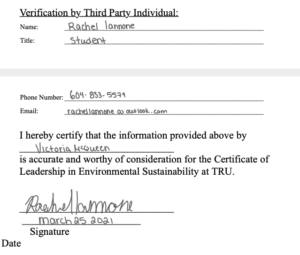
ENSU 1000: LEADERSHIP IN ENVIRONMENTAL SUSTAINABILITY
Verification Form
Category F – Course Related Work
Name: Tori McQueen Points Earned: 3
Please check the category that applies to you:
☐ Create or write a paper, poster, or project for a class (1 point)
☒ Present within TRU (3 points)
☐ Present or publish a paper, poster, or project outside of TRU (5 points)
TO VERIFY: Please attach a copy of your coursework and write a reflective paragraph of your coursework and how it relates to environmental sustainability in your e-Portfolio. If you presented your work, please complete the section below.
|
Location of Presentation: Old Main, TRU |
|
|
Summary of the Presentation: |
|
|
|
|
We presented this in front of our communications class, directed by Susan Bios. |
|
|
Dates/Duration of Presentation: |
March 21, 2019 |

| Low (1) | Medium (3) | High (5) |
| Create or write a paper or project or poster | Present to TRU community | Present or publish paper or project or poster outside TRU |
Researchers are looking into how earthquakes are caused when glaciers drop icebergs into the ocean, where this most likely to happen, how the size of the iceberg, the intensity and magnitude of the earthquake relate to each other. The severity of the earthquake and the mass of the huge ice cube have an instant effect on each other and are directly linked.When a glacier melts or loses large chunks of ice, and takes with it all its weight off of the landmass that has pushed Earth down, the land then rises up again which can also cause an earthquake, due to all the water rushing out of the area. A direct cause of global warming will be the increasing of seismic activity around areas that previously would have been dormant, or not active at all.
In a graph showing a zoomed-in south flank of an icecap sitting atop a volcano found in Iceland. Locations and depth dispersal of the Gvendarfell seismic events, from a marked are where: grey = all regions from 2011–2013 that experienced an earthquake; red = 30 seismic events in summer 2014, which are shown to be at around the centre of the grey dots on the ice cap. In the dead centre of this, there is a star, which represents the average location (N63°32.772′, W19°06.588′) and corresponds to the average origin of the earthquakes. Black triangles found on this graph are the seismic stations. The glacier outline (in blue) is taken from LiDAR DEM gathered in 2010 (Jóhannesson et al., 2013). LiDAR is a light detection system.
An often overlooked factor affecting glaciers and earthquake events is climate change. The trend towards warming global temperatures causes an increase in methane gas accumulating in the ice shelves and building up pressure, and leading to violent explosions. This, without a doubt will cause earthquakes, especially along fault lines. Due to this rapid melting of glaciers, earthquakes are becoming more and more common along the tectonic plate boundaries where glaciers previously existed and helped stabilize it. This research can be applied globally and could be helpful with our current rate of global warming and climate to predict future earthquakes in glacial areas.
Research teams that have collected data in and around glaciers have been using a variety of instruments and using various methods. The most common and by far the most useful tools used were seismometers and satellites to look at the impacts and tendencies in areas with shrinking and dying glaciers.
Emily Chung with CBC News recently published an article that melting glaciers cause another powerful and strong force- tsunamis, and large ones too.These tsunamis are mainly caused by melting glaciers dropping ice chunks, but sometimes an earthquake will cause ice chunks to fall down or landslide debris to fall into a waterbody. Scientists say that these major and destructive events are becoming more common. The increase could be a significant hazard to human settlements and in the surrounding wild areas, spripping them bare of everything. These glacial (and landslide) caused tsunamis are often times massive, some of them over 50 metres tall and a few metres in diameter. Researchers are hoping that their findings will help others predict the risk of these events in all parts of the world. Climate change has affected the frequency of these events and also the location, as these tsunamis don’t always occur on the coast, but have been documented happening far inland. The ideal recipe to create a tsunami is steep topography and a body of water close by.
There’s few things in nature that are extraordinarily out of our control as glaciers and earthquakes. No one can stop these incredible forces of nature, and maybe thats why were attracted to them, but humans also fear them. However, these beasts, once predictable, have now become unstable, and in the glacier’s case, disappearing. Researchers are finding that glaciers dropping ice and earthquakes go hand-in-hand, and can use one to help predict the other; but the power of these forces is a forced to be respected.